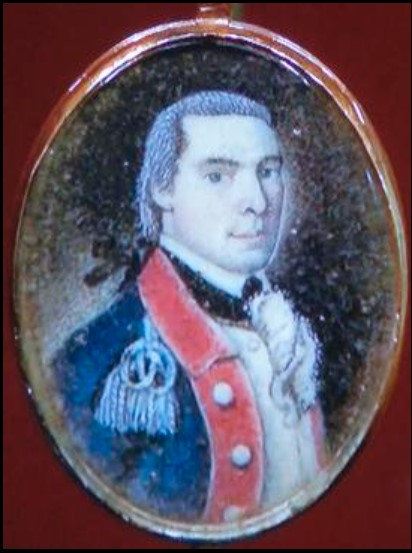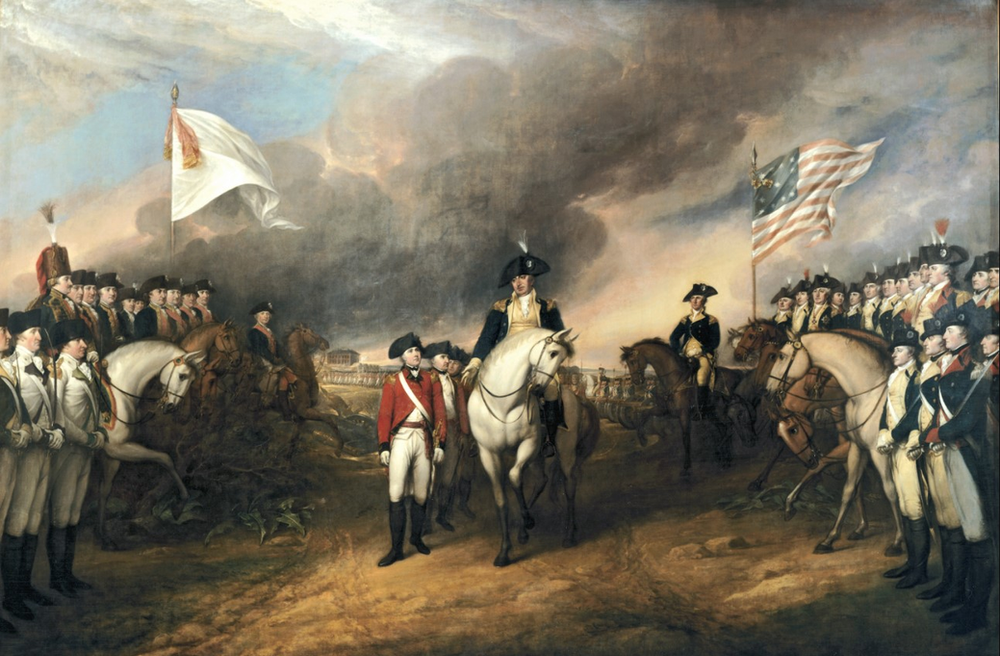Getting to Know William Colfax
By: Tessa Payer, Museum Specialist at the Wayne Museum and Staff Member of the Passaic County Department of Cultural & Historic Affairs
In his 1896 book Ballads of New Jersey in the Revolution, Charles C. Platt included “Capt. Colfax and the Life Guard”, an homage to Wayne resident William Colfax. Platt immortalized this occupant of Wayne’s Schuyler-Colfax House in verse as “a trusty warrior he/well pleasing to ladies all/for his brave gallantry.” Behind the poetry, who was William Colfax?

William Colfax was born in 1756, the son of George Colfax and Lucy Avery of New London, Connecticut. Unfortunately, little is currently known about his childhood, but he came of age during a turbulent time in the colonies, particularly New England. He grew up hearing news of the Stamp Act and other direct taxes from England, conflict in Boston (from the Tea Party to the Massacre), and the formation of Committees of Correspondence and other political rumblings. Only a month after the ‘shot heard ‘round the world’ at Lexington and Concord in 1775, William enlisted in Col. Samuel H. Parson’s 6th Connecticut Regiment. He continued to rise in the ranks throughout his service: he was promoted to Ensign in January 1777 and Second Lieutenant a year later. Years later, in his pension application, William would recall fighting in the battles of Bunker Hill, White Plains, Germantown, Monmouth, Springfield, and the famous battle of Yorktown.
Despite his long service with various Connecticut regiments, William is probably best known as a member of General George Washington’s Life Guard, tasked with protecting Washington, as well as the Continental Army’s cash and papers. By 1778, they were chosen by Frederich von Steuben, recently appointed Inspector General, to serve as a demonstration unit for the Continental Army. Washington was very specific regarding the type of soldier he wanted closest to him, and stated in general orders on March 11th, 1776:
“The General being desirous of selecting a particular number of men, as a Guard for himself, and baggage, The Colonel, or commanding Officer, of each of the established Regiments…will furnish him with four, that the number wanted may be chosen out of them. His Excellency depends upon the Colonels for good Men, such as they can recommend for their sobriety, honesty, and good behaviour; he wishes them to be from five feet, eight inches high, to five feet, ten inches; handsomely and well made, and as there is nothing in his eyes more desirable, than Cleanliness in a Soldier, he desires that particular attention may be made, in the choice of such men, as are neat, and spruce.”
In his Biographical Sketch of William Colfax, William Nelson describes his subject rather romantically as “a man of fine presence; about five feet ten inches in height, large frame, well proportioned, and weighing about 190 or 200 pounds. He had dark hair, a clean-shaven face, with massive, square-set under jaw, a clear, florid complexion, and beautiful blue eyes. His hair was powdered and worn in a cue, tied with a black ribbon, till his later years…this neatness of dress characterized his appearance all his life.” If Nelson’s description is to be believed, William would’ve fit right in with Washington’s high standards.

William was assigned to the Life Guard in April 1778, where he served under the command of Captain Caleb Gibbs. In March 1779, he was promoted to First Lieutenant, and became Lieutenant-Commandant at the end of 1780, following Gibbs’ transfer to another regiment. According to his pension records, he served as a member of the Life Guard until the end of the war in 1783, though he remained involved with the Connecticut regiments noted earlier. He was eventually promoted to the rank of Captain.
William’s service as a member of the Life Guard was what first brought him to Wayne Township. In the summer of 1780, he accompanied Washington to his temporary military headquarters at Bloomsbury, the home of Theunis and Hester Dey- today preserved as the Dey Mansion Washington’s Headquarters. Along with the other guards, William occupied the Dey’s attic- considering the summer weather lately, it must have been sweltering.
It is likely at the Dey’s home that William first met his future wife, Esther Schuyler. Esther was a well-connected young woman; great-granddaughter of one of Wayne’s first European colonists, heiress of the Schuyler estate in Wayne, and niece of Hester and Theunis Dey. Their relationship was one of countless wartime romances, comparable to that of Alexander Hamilton and Elizabeth Schuyler. After their first meeting that summer, the couple may have reunited when the Continental Army returned to the Dey’s home that fall. Otherwise, they remained in contact through correspondence, which does not survive today. Like Hamilton, William may have alluded to the army’s movements in his letters, keeping Esther up to date as the Continental Army met up with French forces and eventually set their sights on Yorktown, Virginia in the fall of 1781. According to Nelson, William witnessed Lord Cornwallis’s surrender following the Battle of Yorktown and “was never tired of describing in after years that memorable scene”; it’s easy to imagine Esther receiving letters gushing about the event.

William remained with the army as the Revolutionary War wound to an end. In July 1783, he was granted an extended furlough and a new promotion to Captain. Taking advantage of the opportunity, he returned to Wayne, and on August 27th, 1783, he married Esther. In November, a month after the Treaty of Paris was ratified and the United States was officially recognized as an independent country, William left the army, returning to private life in Wayne.
Esther inherited her family home upon her father’s death, and the couple’s residency there has given the building it’s modern name: the Schuyler-Colfax House. Though Esther had grown up in the one-story building onsite, she and William added the distinctive two-story building; this added eight new rooms and two large hallways to the home. William’s estate inventory, a list of property taken after his death in 1838, illustrates the material wealth of the family. The couple developed their property into a farm, which boasted cows and oxen, horses, poultry, and pigs, as well as lots of flax, wheat, oats, and hay. The Schuyler-Colfax House was decorated with multiple carpets, mahogany tables, stands, and mirror frames, prints and maps, a “lot of books”, a desk and a bureau. William and Esther traversed their property on one of three wagons, two sleds, or a “pleasure sleigh.” Their home and farm were made prosperous based on the labor of African Americans enslaved by William Colfax. Today, the Wayne Museum has bills of sale for at least people who William purchased during his life in Wayne: Sam, Bob, Cuff, Pero, Nelly and her two-year-old son, Prince (or Touseant), and Joe. Three enslaved individuals- Joe, Peg, and Phebe- are also mentioned in William’s will. To learn more about the experience of enslaved individuals at the Schuyler-Colfax House, click here!

While he listed himself in his pension application as a farmer (relying on the labor of enslaved people), William was active in local politics. He served as a Justice of the Peace for the Court of Common Pleas of Bergen County for many years after being appointed by the legislature. From 1806 to 1813, he was a member of the New Jersey legislature, serving in the General Assembly, as well as the Legislative Council. His military service continued after the American Revolution. In June 1793, he was promoted to the rank of Major of the Third Regiment of the Bergen County militia and was later promoted to Lieutenant Colonel. He also served during the War of 1812, rising to the rank of General and aiding with the defense of Sandy Hook.
William Colfax died on September 9, 1838 at the age of 82. He is buried in the Colfax Family Cemetery, next to the Schuyler-Colfax House.
The Wayne Museum operates under a shared services agreement between the Township of Wayne and the County of Passaic. The County manages and operates the Wayne Museum on the Township’s behalf through the County’s Department of Cultural & Historic Affairs.
Bibliography
Nelson, William. Biographical Sketch of William Colfax, Captain of Washington’s Body Guard. New Jersey Historical Society, 1876. https://play.google.com/books/reader?id=ETYuAAAAYAAJ&pg=GBS.PA145&hl=en.
“Ballad Of Captain Colfax,” Pequannock Township. Accessed July 20th, 2022. https://www.peqtwp.org/249/Ballad-Of-Captain-Colfax.
“Timeline of the Revolution,” National Park Service. Accessed July 22nd, 2022. https://www.nps.gov/subjects/americanrevolution/timeline.htm.
Capps, Alan. “Life Guards,” George Washington’s Mount Vernon- Digital Encyclopedia. Accessed July 20th, 2022. https://www.mountvernon.org/library/digitalhistory/digital-encyclopedia/article/life-guards/.
Fore, Samuel K. “Caleb Gibbs,” George Washington’s Mount Vernon- Digital Encyclopedia. Accessed July 20th, 2022. https://www.mountvernon.org/library/digitalhistory/digital-encyclopedia/article/caleb-gibbs/.
“Bezaleel Howe,” The Society of the Cincinnati in the State of New Hampshire. Accessed July 22nd, 2022. https://www.socnh.org/bezaleel-howe/.
“William Coit House (1763),” Historic Buildings of Connecticut. Accessed July 22nd, 2022. https://historicbuildingsct.com/the-william-coit-house-1763/.
General Orders, 11 March 1776. Document. From Founders Online, National Archives, https://founders.archives.gov/?q=%22His%20Excellency%20depends%20upon%20the%20colonels%22&s=1111311111&sa=&r=1&sr=.
General Orders, 17 March 1778. Document. From Founders Online, National Archives, https://founders.archives.gov/?q=%22one%20hundred%20chosen%20men%20are%20to%20be%20annexed%22&s=1111311111&sa=&r=1&sr=.
Washington, George. George Washington to William Colfax, 28 August 1781. Letter. From Founders Online, National Archives, https://founders.archives.gov/?q=%22Colfax%22&s=1111311111&sa=&r=6&sr=.
“General von Steuben,” Valley Forge- National Park Service. Accessed July 21st, 2022. https://www.nps.gov/vafo/learn/historyculture/vonsteuben.htm.
Berce, William. Under the Sign of the Eagle. Wayne: Louis J. Vorgetts, 1965.
New Jersey, William Colfax. Document. Ancestry.com. U.S., Revolutionary War Pension and Bounty-Land Warrant Application Files, 1800-1900 [database on-line]. Provo, UT, USA: Ancestry.com Operations, Inc., 2010.
A true and perfect inventory of all and singular the goods and chattels rights and credits of William Colfax…22 September 1838. Document. From the Wayne Museum.
Will of William Colfax, July 8th, 1838. New Jersey Surrogate’s Court (Passaic County). Ancestry.com. New Jersey, U.S., Wills and Probate Records, 1739-1991 [database on-line]. Provo, UT, USA: Ancestry.com Operations, Inc., 2015.
Martin Van Houten to William Colfax. Bill of Sale, Bob, 1799. Document. From the Wayne Museum.
Peter Van Pelt to William Colfax. Bill of Sale, Cuff, 1810-1819. Document. From the Wayne Museum.
Garret Post to William Colfax. Bill of Sale, Pero, 1811. Document. From the Wayne Museum.
George Ryerson to William Colfax. Bill of Sale, Nelly and son, 29 July 1816. Document. From the Wayne Museum.
Garret Marsales to William Colfax. Bill of Sale, Prince, or Touseant, 1831. Document. From the Wayne Museum.
John Post to William Colfax. Bill of Sale, Joe, 1831. Document. From the Wayne Museum.
